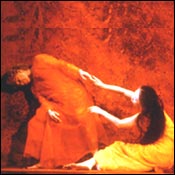
How little can a dancer move and still be said to be dancing? The question is nowhere better explored than in the creations of Eiko & Koma, recently seen at the Joyce.
For some 25 years, the Japanese-born husband-and-wife team have been choreographing and performing hypnotic two-person works, often set in mystery-suffused scenic environments of their own creation. Although they are essentially sui generis, they have been influenced by Mary Wigman’s concept of space as the dancer’s partner, and by the ideas and tactics of butoh, the post-Hiroshima genre that deals with life doggedly re-emerging from extinction and takes slow motion to extremes.
A typical Eiko & Koma production is the 1999 Snow, first seen in New York on the Joyce program. The piece is an exquisite exercise in darkness barely illuminated by moonlight and stillness barely disturbed by small, muted shifts in the figures’ posture, gestures, and placement in the wintry landscape. The pale flakes inexorably falling upon the white-gowned Eiko and the jet-cloaked Koma (who is, as often as not, half hidden in shadow) read as a metaphor for tears, a kind of cosmic weeping for the sorrow of an unhappy pair of lovers. Both the softly falling snow and the minimally stirring figures seem to aspire to a state of suspended animation. The viewer’s attention is compelled not by action, as is the norm in dance, but by suggestion. Brought into being through the artists’ reticence, concentration, and pictorial imagination, the element of suggestion is astonishingly varied and powerful. Snow conjures up a host of ancient Japanese legends in which malevolent demons devour romance as if it were their prey, as well as nineteenth-century works in the Western canon – Italian operas, French and Russian novels – in which erotic love clasps hands so avidly with tragic death.
Snow is undeniably a fine piece, but nothing new in the Eiko & Koma realm. Indeed, to the viewer not as seduced by its loveliness as I was, it might seem to be that same damned dance the pair keeps doing, with ever more attention to décor, under a title that changes annually. Perhaps the artists themselves realized that they’ve been painting themselves into a corner (albeit an attractive one), because they were persuaded last year to join forces with Anna Halprin, an avant-gardist in at the birth of postmodern dance who is still feisty at 81.
Together, the trio worked out a piece called Be With, which became the featured number in the Joyce concert, if only for its novelty. In it, the cellist Joan Jeanrenaud plays her own advanced music onstage while the three dancers, clad in ravishing costumes of crumpled gauze in fiery hues, do things in an Eiko & Koma-ish mode, backed by a wall that looks like crushed stone lit by flame. And all of a sudden, this stuff starts telling stories! Halprin appears to be the aged female of the tribe who must be escorted, willingly or no, to her death; a generic nurturing mother who brings solace to Eiko; a mother-in-law to Koma, who confronts her almost brutally, and perhaps sexually. Forty minutes of what might be taken by the irreverent for an ethnographic soap opera concludes with a contrived epiphany in which the three protagonists are raised on high, looking like statuary representing household gods.
What’s going on? When they operate alone, Eiko & Koma are not characters in a narrative or even in a situation. They’re more like elements of nature, life at a stage of development distinctly primordial, only slightly more apprehending than stones, rivers, and trees. Halprin’s presence changes the nature of what occurs not because she is Caucasian but because her contribution has forced upon Eiko & Koma’s private universe concerns and attitudes of Western culture innately alien to it. Be With was a worthy experiment. It simply turned out not to be the solution to the Eiko & Koma dilemma, common to inventors in a radical, narrow mode: Where do we go from here?
Eiko & Koma and Anna Halprin
At the Joyce Theater.